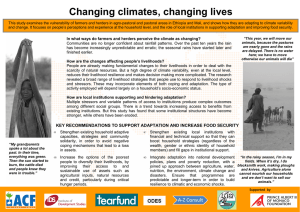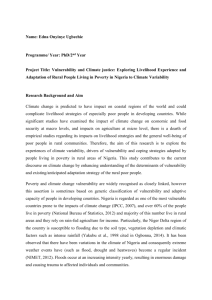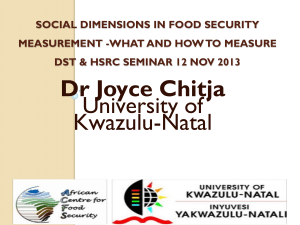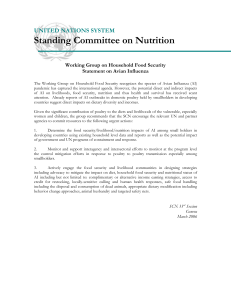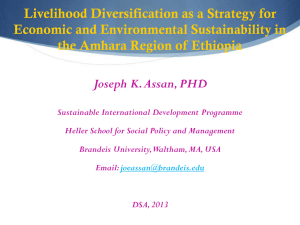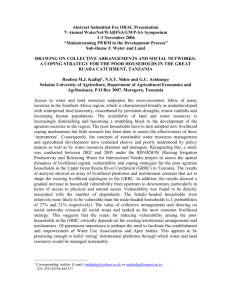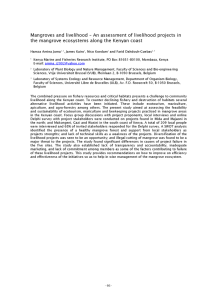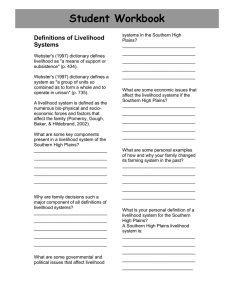se and Ea
advertisement
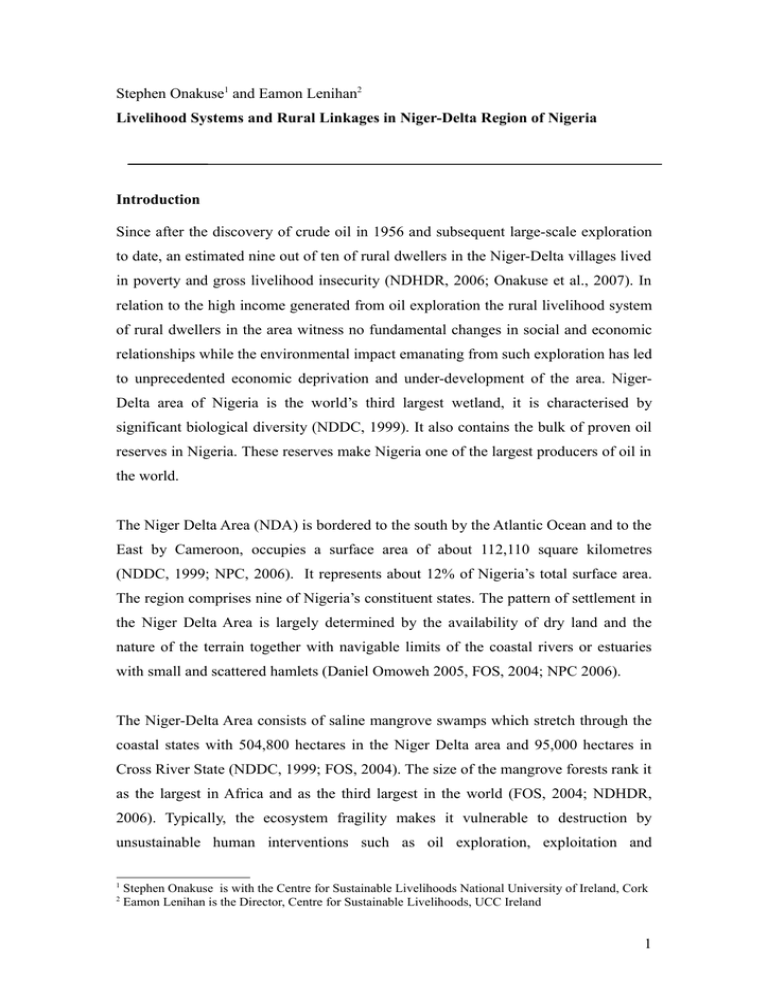
Stephen Onakuse1 and Eamon Lenihan2 Livelihood Systems and Rural Linkages in Niger-Delta Region of Nigeria Introduction Since after the discovery of crude oil in 1956 and subsequent large-scale exploration to date, an estimated nine out of ten of rural dwellers in the Niger-Delta villages lived in poverty and gross livelihood insecurity (NDHDR, 2006; Onakuse et al., 2007). In relation to the high income generated from oil exploration the rural livelihood system of rural dwellers in the area witness no fundamental changes in social and economic relationships while the environmental impact emanating from such exploration has led to unprecedented economic deprivation and under-development of the area. NigerDelta area of Nigeria is the world’s third largest wetland, it is characterised by significant biological diversity (NDDC, 1999). It also contains the bulk of proven oil reserves in Nigeria. These reserves make Nigeria one of the largest producers of oil in the world. The Niger Delta Area (NDA) is bordered to the south by the Atlantic Ocean and to the East by Cameroon, occupies a surface area of about 112,110 square kilometres (NDDC, 1999; NPC, 2006). It represents about 12% of Nigeria’s total surface area. The region comprises nine of Nigeria’s constituent states. The pattern of settlement in the Niger Delta Area is largely determined by the availability of dry land and the nature of the terrain together with navigable limits of the coastal rivers or estuaries with small and scattered hamlets (Daniel Omoweh 2005, FOS, 2004; NPC 2006). The Niger-Delta Area consists of saline mangrove swamps which stretch through the coastal states with 504,800 hectares in the Niger Delta area and 95,000 hectares in Cross River State (NDDC, 1999; FOS, 2004). The size of the mangrove forests rank it as the largest in Africa and as the third largest in the world (FOS, 2004; NDHDR, 2006). Typically, the ecosystem fragility makes it vulnerable to destruction by unsustainable human interventions such as oil exploration, exploitation and 1 2 Stephen Onakuse is with the Centre for Sustainable Livelihoods National University of Ireland, Cork Eamon Lenihan is the Director, Centre for Sustainable Livelihoods, UCC Ireland 1 transportation processes. The inhabitants of historical settlements in the Niger Delta area depend on fish and other mangrove resources for their livelihood. Mangrove wood provide multi-purpose resource for fish stakes, fish traps, boat building, boat paddles, yam stakes, fencing, carvings, building timber and fuel (NDDC, 1999). Table 1.1: States composed of the Niger Delta Area, Land Area and Population State Land Area Population (square kilometres) (NPC 2006) Abia State 4,877. 2,833,999 Akwa Ibom 6,806 3,920,208 Vállelas 11,007 1,703,358 Cross River 21,930 2,888,966 Delta 17,163 4,098,391 Edo 19,698 3,218,332 Imo 5,165 3,934,899 Ondo 15,086 3,441,014 Rivers 10,378 5,185,420 Totals 112,110 31, 224, 587 Sources: National Population Commission Provisional (NPC, 2006) Result based on 2005 Census Across the Niger Delta area, 65 per cent of the population depends on the natural environment—living and non-living—for their livelihoods while the other 35% depends on remittance (CASS, 2003; Daniel Omoweh, 2005; Onakuse et al., 2007). While the best contraception for the control and prevention of livelihood insecurity are education, access to assets of production (agricultural lands), good health care system, transport network, market, rule of law and many others, the government over the years have initiated strategic programmes since after the Willink’s Commission was set up in 1959 to look into the problems of the Niger delta area. Among the recommendations of the Willink’s Commission was the establishment of a development board, the Niger Delta Development Board to tackle the problem of physical development of the difficult terrain of the area. The Federal government over time has initiated programmes such as: Niger Delta Development Board (NDDB) in 1961; Niger Delta River Basin Development Authority (NDBDA) in 1976; Oil Mineral Producing Areas Development Commission (OMPADEC) in 1992; and the very current Niger Delta Development Commission (NDDC) in 2000 aimed at developing the area. Despite all the programmes, Oil and gas exploration and 2 exploitation have continued to infringe on rural peoples livelihoods and their environment in the area. The study of the Niger-Delta area livelihood security3 is aimed to provide an understanding of the nature and factors precipitating livelihood insecurity in the area. The process and procedure for determining these understanding, explores the devastation of the environment and ecological imbalance created by oil and gas exploitation and its contribution to social and economic deprivation – that leads to loss of fishing grounds, the disappearance of agricultural lands, serious health consequences and other related environmental hazards. To provide high-quality information to policymakers in national, state and local governments on service provision through integrated community-based organizations approaches To understand the strategies rural dwellers use to cope with the impact of environmental degradation based on informal safety nets and remittance The study offers suggestions on policy improvement mechanism that could be explored to address the underlying causes of livelihood insecurity and poverty in the area. These policy options include interventions to support livelihoods, promote livelihood security activities and create an enabling environment for communitybased informal safety nets. Livelihood Systems in Niger-Delta Villages Livelihoods4 in Niger-Delta villages are limited to a fairly narrow range of activities, but these activities may be combined in complex ways and are sometimes short lived 3 Some analysts define livelihood security in terms of outcomes—particularly sustainable access to sufficient income (Frankenberger 1996). A livelihood "comprises the capabilities, assets (stores, resources, claims, and access) and activities required for a means of living; a livelihood is sustainable which can cope with and recover from stress and shocks, maintain or enhance its capabilities and assets, and provide sustainable livelihood opportunities for the next generation" (Chambers & Conway 1992). 4 Livelihoods are the sum of ways in which people make a living. In most communities in low-income countries, poor families balance a set of food and income-earning activities (Carney D. 1998). A means of earning a living employment, income, job, work, career, occupation, living, maintenance, means, subsistence, support etc. 3 due to both environmental and communal conflict. For this reason, characterising livelihood systems at the household level becomes difficult, except with reference to the primary activity of the main income earners which are indigenous knowledge5 and locally based. A livelihood comprises the capabilities, assets (including both material and social resources) and activities required for a means of living. Livelihood becomes sustainable when it can cope with and recover from stresses and shocks and maintain or enhance its capabilities and assets both now and in the future, while not undermining the natural resource base (Chambers, R. and G. Conway, 1992). The identity of and the peculiar nature of the Niger-Delta area environment, explicates the vulnerability of the rural dwellers to lack of or absence of minimum levels of sources of income and employment opportunities, access to health care, education, safe drinking water, etc, that could lead to a situation that exists when people have secure access to sufficient amounts of safe and nutritious food for normal growth and development and an active life (Maxwell, 1999; FAO, 2002; Carney, 1998). Livelihood insecurity is a siege of death coupled with the impact of environmental destruction emanating from oil exploration, which shut out the bulk of the area human population from the dignity befitting of human. This makes food insecurity a sociopolitical time bomb currently unfolding in the area – a burden for both the actor and spectators. Livelihood systems are much more than sets of material and economic conditions. While rural dwellers in Niger-Delta have to cater for a large number of human needs such as food and shelter, they also need to address concerns of the human attachment to the environment. Hence, sustainability of rural livelihood systems is not only a matter of physical resources and physical duration, but also of psychic fulfilment and cultural meaning. The large and persistent gap between agricultural activities and livelihood security in the Niger-Delta area with little or no formal sources of income and unemployment suggests that livelihood security is dependent on agriculture in rural areas—as many cannot afford to sustain their livelihoods through agricultural practices as sources of income for the households as shown on table 2; it further 5 There are many closely related concepts in use - local knowledge, indigenous knowledge, traditional knowledge, etc. - which refer to the knowledge that people in a given place and culture have developed over time, and continue to develop. This is thus based on experience, often tested over centuries of use, adapted to local culture and environment and dynamic and changing. 4 increases the number of the rural poor to remain in perpetual food insecure state in the area. Table 2: Source of Income of Poor and Non-poor Families at Niger-Delta Area Sector Poor Families Non-poor Families Labour Farm and non-farm labour Not a source of income Agriculture Any kinds of cereals, root crops Rubber, Oil Palm and coconut and legumes Livestock Chickens, ducks, goats Goats, chicken, and ducks Fishing Fish/Shrimps/Sea food Not a source of income Processing Palm wine, local gin & Banga Not a source of income Shop, kiosk Shopkeeper Owner Skills used Make fishing equipment, Skills for outside salaried basket making broom making from employment or business skills coconut leaves, and making fishing nets Source: Participatory rural assessment activities in Niger-Delta (2003). Livelihoods in the greater part of Niger-Delta area rural villages surveyed are constantly exposed to the impact from environmental pollution causing a great loss in both flora and fauna – a major source of livelihoods based on the indigenous people— farming and fishing practices—which has been lost due to environmental degradation and climatic changes as currently experienced worldwide. Of more importance to them are the network of paths, tracks and access routes in the immediate village vicinity, dotted with criss-crossing pipelines and oil stations on which they rely to access water, firewood, fields, and local market opportunities. Therefore, increasing mobility within the village is important to enable access to means of livelihoods – income such as markets outside the village. While rural roads can be social and economic arteries for communities in a broader sense, the myriad of environmental impacts from oil and gas exploration further compound the livelihood status of rural poor who lack access to assets of production sufficient to feed a family, or who have just enough to sustain families but with no surplus. Therefore, children becomes a potential source of future livelihood security 5 for poor families, through urban-rural remittances6 in cash and kind, including food products known to have a profound effect on the livelihoods of different households (Onakuse et al., 2007). The focus on the receiving household is based on how they see remittances as an external source of income earned by someone living elsewhere further remitted to secure livelihood for those left behind Dependence on remittance is now an understood strategy rural communities adopt to cope with livelihood insecurity (including informal safety nets) (Onakuse et al., 2007). The localised impacts of remittance of livelihoods has covered the not readily accessible credit from unprotected sources required for start-up capital to diversify their sources of income which makes rural poor to be more dependent on agriculture and since remittance since they are located away from major cities. The assets, strategies, and outcomes at both households and community levels are closely related and understood in terms of environmental degradation which increases livelihood insecurity. The levels of vulnerability is further exacerbated by the political, economic, corporate social responsibility of both major and minor oil companies operation located either in the heart of the communities or near by. The head of the family and individual decision-makers within households organise and manage their labour-based, income-generating activities and other forms of income through both formal and informal safety nets, kinship networks, and also securing for the future through outward migration Changes in Sources of Livelihoods since the Advent of Oil Exploration The environment is important to people living in poverty in Niger-Delta area villages surveyed not only because their existence to a large extent relies on subsistence endeavours, which depend on natural resources, but also because they perceive their well-being as tied to their environment in terms of livelihoods, health, vulnerability and the ability to control their lives. Poorer people are more vulnerable to changes in the environment, in part because social, political and economic exclusion means they almost always have fewer choices about where they live. They bear the brunt of 6 Remittances are sums of money or goods sent between individuals over some distance, that is transfers between migrants and their places of origin. For the purpose of this research, it is defined as income (in any form) received by a household in one distinct place, from individuals or households living in another place to improve livelihood. 6 natural hazards, biodiversity loss and the depletion of forests, pollution (air, water and soil), and the negative impacts of industrial activities on and offshore. Oil prospecting and exploitation are known worldwide for their negative environmental and social impact on host community on the one hand and worldwide on the other to include: loss of indigenous peoples' or peasants' lands, health problems, destruction of rainforests, pollution of water sources and air (NDDC, 1999; CASS, 2003; NDHDR 2006). The economic activities of Niger-Delta area comprise of land based type on the drier land at the northern end of the Delta, which includes farming, fishing, collecting and processing palm fruits, as well as hunting and water based type of livelihood systems with a less diversified economy. Decades of oil prospecting and exploitation in the Niger Delta have damaged much of the ecosystem of the region. The Nigeria National Petroleum Corporation estimate, based on reported cases of spillage, between 1976 and 1996, there were a total of 4,835 incidents resulting in the spillage of at least 2,446,322 barrels (102.7 million US gallons), of which an estimated 1,896,930 barrels (79.7 million US gallons; 77 percent) were lost to the environment (NDHDR, 2006; NNPC, 2007). The result has been a general deterioration of economic, social and political cohesion. Conflict has become a booming business, with grave implications for future development prospects. Already entrenched are productivity losses, weak entrepreneurial skills, the destruction of traditional institutions that formerly served as reservoirs of social capital, the disregard of formal and informal authorities, and insecure property rights. This ongoing dissent denies the region lasting security, enduring peace and prosperity, and the realisation of abundant opportunities. Another calculation based on oil industry sources, estimates that: more than 1.07 million barrels (45million US gallons) of oil were spilled in Nigeria from 1960 to 1997. Nigeria's largest spill was an offshore well blow out in January 1980, when at least 200,000 barrels of oil (8.4 million US gallons), according to industry sources, spewed into the Atlantic Ocean from Texaco facility and destroyed 340 hectares of mangroves. Directorate of Petroleum Resources estimates were that more than 400,000 barrels (16.8 million US gallons) were spilled in this incident. The entire Niger Delta region being the longest mangrove forest in Nigeria, the mangrove is 7 particularly vulnerable to oil spills, because the soil soaks up the oil like a sponge and releases it every raining season, thereby causing more damage to wider area than anticipated (CASS, 2003; Daniel Omoweh, 2005; NDHDR, 2006). Overall, the complete destruction of natural, social and cultural assets which gives meaning to other assets of production by contributing to social cohesion and a sense of shared identity and knowledge which, in turn, are often essential to enable vulnerable groups to negotiate livelihood access within their locality have been mortgaged through political insensitivity and corruption. Because rural livelihoods are tied to land, the ownership of which is also vested in the Nigerian state serves a constraint to its access. The traditional economy still subsists on land and water resources with 80 percent of the population engaged in fishing in the coastal communities. About 10 percent of the population are engaged in building canoes, production of native salt, tapping palm trees, raffia palm trees, and petty trade, among others as shown on table 2. The growth of other food crops is sustained with the application of indigenous knowledge in the governance of both land and water resources. Food gathering through rural water and forestry resources among the rural poor constitutes viable sources of livelihoods for the rural dwellers. But the consistent and reckless activities emanating from oil exploration and transportation such as the one of 1980, at Finuwa, Sangana, where one of the wellheads blew out, the entire jack-up rig razed down, and spilled for about 4 weeks. An estimated 3 million barrels of crude were spilled and all lost to the environment. Such spillage wholly affect the major occupation of the people thereby making food gathering no longer protected as a local livelihood security strategy, particularly as the rural resources have, under gas flaring and oil spillages and indiscriminate dumping of untreated drilling water-based wastes on land and into the swamps are the norm. The well-being of various communities which are criss-crossed with numerous rivers, most of which are tributaries of the River Niger surveyed that spread across the NigerDelta area of Nigeria has being compromised through oil exploration as the reliability of livelihoods sources (agricultural practices, transportation, nutritious food, and 8 health services provision) becomes more uncertain and elusive as government policies and laws such as the Land use Decree of 19787, which was extracted from the Mineral Act of 1914 and the offshore littoral laws that makes peoples livelihoods and environment more vulnerable to defend and protect against corporations indifference and crude political patronage. The Niger-Delta area, hitherto despised by oil companies’ exploitation who took delight in the subjugation of rural dwellers in the area is culprit to the environmental squalor. The Land Use Act Decree No. 6, which came into force in March 1978, appropriated all lands in the name of the Federal Republic of Nigeria. In 1969, the Federal Government promulgated the Petroleum Act, which forbade individuals from engaging in mining petroleum resources. Decree No.13 of 1970, empowered the centre (FGN) to acquire all federally collected resources, also Decree No. 9 of 1971 which empowers the Federal Government all rights to offshore rents and royalties. These laws and decrees conspicuously differentiate between the Niger-Delta areas as “oil bearing communities” while the Nigeria state retain the position of “oil producing” instead of “oil expropriator”. These laws gives away communal lands, rivers and forests to trans-national companies for the exploration and exploitation of oil and gas and with its attendant loss of land for local livelihoods and dislocation of indigenous communities. The symptomatic nature of livelihood insecurity cutting across the surveyed villages in the Niger-Delta region expose the Nigeria government economic system whose basic operational logical is the removal from the people, especially the poor - of every protection that the state had been compelled to provide against the worst ravages of capitalism during colonial era and the early days of post-colonialism. This explains the overall physical destruction that the planet earth faces from massive environmental degradation from prospecting and exploration from the Niger Delta area and other parts of the world. 7 The Land Use Act ("LUA") was promulgated in 1978 for the purpose of vesting all land within the territory of Nigeria in the Government of Nigeria, with the intention that such land is to be held by the Government in trust for the people of Nigeria and allocated or administered for the use and common benefit of all Nigerians in accordance with the provisions of LUA. The Land Use Act transfers the right of ownership of lands from individuals, households, and communities to the state governors. 9 FAO (2002) identified three groups of vulnerable households: those which would be vulnerable under any circumstances: for example, where the adults are unable to provide an adequate livelihood for the household for reasons of disability, illness, age or some other characteristic; those whose resource endowment is inadequate to provide sufficient income from any available source; and those whose characteristics and resources render them potentially vulnerable in the context of social and economic shocks: e.g. those who find it hard to adapt to sudden changes in economic activity brought about by economic policy. But in the context of Niger-Delta area, the fourth group comprises of those whose natural resources characteristically denies them their livelihoods due to exploration activities. Research Methodology A review of the broad literature on the evolution of livelihood changes in the NigerDelta area was undertaken with a particular focus on the role of environmental degradation. The scope of the study was limited to rural communities who dwell side by side or with the exploration activities in their communities while making use of substantive field research to explore the overall impact and depth of environmental degradation of livelihood activities. The selection of communities where the research was conducted was based on the high level of oil production activities in the area, and the fact that agricultural production is the major occupation of the people. Purposively selected communities were surveyed using a semi-structured interview guide to give a good quantification of the differences between various oil exploration impacts on the environment on households and in the study villages. However, the research was combined both qualitative and quantitative methods. The nature and scope of rural livelihoods and the ways in which rural economic growth is conducted differs from across individuals, households and communities. The methods and tools used for the study were both qualitative and quantitative. The study consciously focused on poor areas to ensure that elements that impact on the poor’s livelihoods could be better captured. Instead of assuming an automatic link between efficient and constructive environmental responsibility for livelihood security, the study methodology gave due consideration to the intervening activities 10 on rural, economy environmental, and institutional factors that determine how people respond to the various shapes of livelihood constraints and opportunities if any. A team of 25 trained enumerators and a research coordinator were recruited for the survey; armed with field research methodology, interviewing skills and familiarity with the community local languages in the study area such as Yoruba, Urhobo, Itsekiri and most importantly Pidgin English. The questionnaire was pre-tested extensively in different rural villages across the area to have a feel of what and how the people might react to enumerators taking into consideration the volatile nature of the area both communal, ethnic and the current hostage taking syndrome. The initial qualitative activity entails a series of household head interviews conducted in a number of communities across the study area. These interviews were designed and conducted to enable modification on survey questionnaire and hypotheses if any and to provide a detailed reconnaissance survey of the study area. The focus group discussions was organised in such a way that it took into consideration gender, age and status of respondents. This allows for different focus group discussions based on the above consideration. Both interviews and focus group discussions were organised in order not to interfere with the various tasks of each household members who are actively involved in sourcing for means of livelihoods; usually in the evenings after coming back from the farms or creeks. At the village level at the early stage of the study a framework through which both discussions with key informants and focus group will be adopted to complement the household survey questionnaire with a sample of 810 households (90 in each state) spread across the selected villages, focusing on livelihood strategies changes, especially agricultural pattern. The use of observation and pictures in addition to the questionnaire, focus group and key informants becomes inevitable as follow-up qualitative investigations in interpreting survey findings. The settlement pattern cutting across the area creates difficulties in proper identification for each housing unit as there was no listing of households available for the enumeration areas. However, the final sample size was 810 households cutting across the nine states, 27 local government areas, three villages from each local government area and ninety households from each village. 11 The major limitation of the survey was travelling through the creeks since most of the roads are not accessible by car. The available means of transportation was by trekking, cycling and through water transport by canoes The Challenges The pervasive livelihood insecurity precipitated by the oil and gas extraction on the entire delta environment remains a major challenge to initiating and attaining a livelihood system across the area. Therefore, it is not possible to discuss sustainable livelihoods in the Niger-Delta without referring to oil extraction and its impacts on the environment. For example, (ERA 2002; CASS, 2003; NDHDR, 2006) studies have shown that non-timber forest products, such as firewood, snails, medicinal plants and spices, have significantly declined in recent years due to pollution and deforestation. Focus group participants claimed that constant discharge of effluent and waste from oil operations onto land, into mangrove and freshwater swamps, and into the sea have destroyed their food and cash crops in addition to destroying arable and fertile farmlands with further alteration on the ecosystem. The people of the oil producing communities are living with the oil are suffering with the consequences of the exploration. Agriculture remains the most dominant economic activity in the Niger Delta area with crop farming and fishing activities account for about 90% of all forms of activities in the area while about 50%-68% of the active labour force is engaged in one form of agricultural activity or the other including fishing and farming (FOS, 2004). The agricultural pattern in the area remains the use of land rotation or bush fallow system characterised by land and labour being the principal inputs of production. The advent of oil extraction and production has led to adverse environmental impact on the soil, forest and water of the Niger Delta area communities. This has ultimately affected subsistence agriculture in a variety of ways, such as rural urban migration and exalting pressure on scarce fertile lands to obtain other means of livelihood. Farm land pollution was identified as a major problem as a socio-economic impact of oil exploration in Niger Delta the consequences well entrenched through decline in soil and Marine resources, land degradation, regular displacement without 12 resettlement during oil spills, fall in output of the agricultural product, intensive exploitation of other fertile lands leading to increase livelihood insecurity. Oil exploration and production in the Niger Delta, is known to release detrimental materials into the environment e.g. during exploration, drill cuttings, drill mud and fluids used for stimulating production are released into the environment with heavy consequences of agricultural lands. The major constituents of drill cuttings such as barytes and bentonite clays when dumped on the ground prevent plant growth until natural processes develop new topsoil. People survive primarily through their own labour (growing crops; hunting and gathering; working for a meal or sack of grain; trading and bartering; income generating activities; etc.). Different options for survival are available to different people depending on where they live (the agro-ecological zone) and what resources they have (cash, savings, loans, labour, and so on). The possibilities are many but not endless; in fact, the range of options are rather limited. People produce food; they exchange things for food; or they earn cash to buy food. Therefore, investment in existing CBOs through traditional knowledge could contribute to the sustainability of livelihoods in the longer term (Anna Toner 2003, Onakuse et al., 2007). The key role of community-based organisations harnessed through informal associations, networks and extended families at rural community level, and by the social relationships that connect local initiatives to create opportunities for livelihood security methods, could create an easy access to actualising rural poor people livelihood security (Onakuse et al., 2007). The other challenge which keeps on re-appearing in all areas is the lack of linkage between economic growth and poverty reduction as shaped by low employment intensity of the growth process and the inability of the poor people to integrate into the growth process and reap the gains from employment opportunities. Ramallion (1992), posit that farm size and the head of the household- labour availability in the household are vital indicators to determine landlessness, an important asset of production. However, the three indicators may not provide by themselves a complete picture of the economic dimensions of livelihood security at the household level when the impact of environmental degradation on this vital asset of production has continued unabated for five decades. The general impact of oil exploration in the 13 Niger-Delta area of could be classified under three key dimensions of human poverty —insufficient livelihoods, poor health and vulnerability8. A quick overview of the impact of some of these activities shows that the heat from gas flare kills vegetation, suppresses the growth and flowering of some plants, and diminishes agricultural production. Plants, animals and humans in the vicinity of the gas flares which are continually exposed to light with no respite at night (See picture 1 below). In Nigeria, over 70% of associated gas is flared with a notorious record of 25% of all gas flared in the world. The Niger-Delta area is home to the total gas flared in Nigeria whereas the average rate of gas flaring in the world is about 4% Biography and Socio-economic Analysis In the course of the research, various communities visited travelling through the creeks and rivers in the area could be observed to be confronted with the dangerous gas flares, oil wells and pipelines flow-stations and seismic lines criss-crossing farm land and waterways. The pollution of the air was quite obvious with the continuous oil spills disrupting the ecological balance making both farming and fishing impossible for many communities. Lack of access road, good transport networks and lack of access to agricultural lands are abundant constraints to local livelihoods and economic development especially when markets. Schools and hospitals are located far away from rural dwellers in all the villages explored. Age and Sex Structure Table three shows the descriptive characteristics of household surveyed. Overall, the mean household size for all household was 5.1 with a 0.4% difference between male and female. However, the differences are magnified still further when the sample is disaggregated into male- and female-headed households by mean age of household head and educational level. In all the study locations, there appears to be a high 8 Vulnerability refers to the full range of factors that place people at risk of becoming food insecure. The degree of vulnerability of an individual, household or group of persons is determined by their exposure to the risk factors and their ability to cope with or withstand stressful situations (FAO 2002). 14 correlation between large family size and livelihood insecurity based on the dependency ratio significant at the 5% level. Table 3: Descriptive characteristics of Niger-Delta households, by head of household All Male-headed Female-headed Characteristic households’ households’ households Mean household size (persons) 5.1 5.2 4.8 Mean age of head (years) (2.3) (2.0) (2.8) 38.0 39.0 37.0 (11.8) (10.2) (14.2) 12.2* 7.5* (7.7) (8.3) (5.4) 1.2 1.1* 1.5* (0.8) (0.7) (1.0) Mean education level of head (years) 10.5 Dependency ratio Source: Field Survey Data (2003). Note: Numbers in parentheses are standard deviations. *Significant at the 5 percent level. Women across the study states are deemed to be responsible primarily for household tasks, and they spend more time on most household tasks. This brings about a wide gender9 disparity in all the various household activities tasks across the surveyed villages. In their travel within the community and outside, men and women have different travel patterns, tasks, and responsibilities. In local travel, responses indicate that both men and women share responsibility to undertake crop production. For water collection, men overall have a slightly lower responsibility (10%) than women (46%). In collecting firewood, another major household task requiring travel within the immediate village area, men and women have different responsibilities. However, in looking at the total time spent to undertake these tasks, women spend nearly thrice as long in firewood collection tasks as men (62% to 22%). The importance of 9 Gender in this context, being the socially constructed roles of men and women and the politics of their relationship 15 firewood collection by women dominates other tasks due to its processing role in fish preservation. But, men are much more involved in local gin production when compared with women (80% to 20%) Housing: Ownership and Facilities Only 47 percent of households own their houses, while 39 percent reside in family compounds and 10 percent rented homes. The remaining 4 percent engage in squatting and shuttling in and out of the village (This group is composed primarily of new migrants displaced by oil spillage and or total destruction to sources of livelihood who lodge with family members, supposedly temporarily). The majority of homes (71 per- cent) are made of thatch, wood and mats. Toilet facilities are mainly in the open field, pit toilet and directly into the rivers as shown on table 4. The hygiene of toilets system was very poor throughout the villages with indiscriminate waste disposal and sometime burning in backyard pits. The pit toilets are water-logged as the water table in most villages is very high. The high levels of the water table makes little or no difference between those defecating directly into rivers and the water-logged pit toilets due to their eventual seepage to the open rivers and streams during high tides. The main sources of drinking water includes: tube well, ring well rivers/canal and sparingly rainwater. There was no single village surveyed with pipe borne water as shown on table 4. Key informant and focus group discussion revealed that the cost of erecting good toilet facilities in the swampy and river nature of the area is responsible for the unhygienic conditions. This phenomenon was reported in 700 of 810 enumeration areas. Since most of the houses are suspended above rivers and swamps, the floors can only be made of woods and sometimes with made of mud with very few houses having cement flooring. Table 4 shows the electric power distribution across the villages across the nine states, where the very poor use mostly kerosene lanterns for lighting their houses. As shown in table 4, these various shortcomings are linked to series of neglect by successive government of Nigeria and oil exploration companies practices linked with environmental degradation across the rural villages in the area which are predisposing 16 factors to water contamination and associated diseases throughout the Niger Delta area. Table 4: Access to Water, Sanitation, Housing and Transportation Item Share of Households (%) Abia A/Ibom Bayelsa C/Rivers Delta Edo Imo Ondo Rivers Drinking Water Tube Well 30.0 28.1 32.2 30.0 31.1 24.4 30.0 31.1 27.8 Ring Well 14.0 16.7 15.8 18.9 16.7 14.4 16.7 17.8 16.7 Piped to House 0.0 0.0 0.0 0.0 0.0 0.0 0.0 0.0 0.0 River/Canal 52.0 52.2 45.0 45.1 48.2 41.1 53.3 47.1 50.8 Rain Water 3.0 4.0 7.0 6.0 2.0 20.0 0.0 4.0 7.0 Open field 31.1 28 30 33.2 28.9 40.8 28.4 26.7 31.1 Pit toilet 41.1 37.3 35.8 32.4 40.9 41.1 40.7 43.3 34.0 Direct to Rivers 22.2 9.6 7.6 28.9 8.6 6.7 5.6 6.6 7.8 Water sealed 5.6 1.3 1.1 4.4 6.9 3.3 18.9 4.4 21.1 Unsealed 0 23.6 25.6 1.1 14.7 8.1 6.4 19.0 6.0 Sanitation Types of Housing Mud 3.6 5.6 4.5 3.6 1.6 6.7 5.6 2.6 4.4 Multi-faceted 34.4 14.4 13.2 25.6 31.1 28.9 33.3 12.2 45.6 Thatch 52.0 55.0 60.2 37.8 43.3 60.3 60.1 52.2 30.0 Huts 10.0 25.0 22.1 33.0 24.0 4.1 2.0 33.0 20.0 Public Transport 24.4 37.4 18.2 38.7 22.2 36.7 39.4 17.7 33.3 Private car 8.1 5.1 6.2 4.2 3.3 8.0 11.1 14.2 7.1 Motorcycle 16.7 19.7 12.7 13.3 15.6 26.7 16.7 14.7 19.8 Bicycle 16.7 16.7 35.6 15.6 25.6 14.4 14.7 15.6 15.8 Transportation 17 Water Canoe 3.0 4.0 11.1 9.1 20.6 3.1 6.0 30.0 10.0 Trekking 31.1 17.1 16.1 19.1 12.8 11.1 13.1 8.9 14.0 Kerosene Lantern 74.4 62.2 73.3 68.2 87.9 62.3 59.4 81.1 72.8 Electricity 24.4 33.8 24.7 31.8 11.1 35.4 36.6 17.7 22.2 Gas Light 1.2 4.0 2.0 0.0 1.0 2.3 4.0 1.2 5.0 Electricity Source: Household survey data (2003). An aggregation by ranking across the rural village’s shows that based on priority needs of local community members through focus group discussion educational facilities was ranked to be the highest priority (36.4 per cent), followed by a good water supply (17.1 per cent), health facilities (15.6 per cent) and facilities to create jobs (11.9 per cent). Other priority needs were roads (7.8 per cent), electricity (6.7 per cent), and a clean environment (4.5 per cent). The priority needs of local populations differs from one community to another especially as their livelihood activities vary The level of involvement in livelihood activities directly affects the income levels of household heads both male and female inclusive (see table 5). About 46% of employed persons in the surveyed households earn less than 5,000 Naira per month. The proportion declines to 20% in the income group 5,001 to 10,000 Naira per month and 11% falls within the 10,001 to 15,000 Naira income range. The proportion of the employed declines further to 9% in the 15,001 to 20,000 Naira income groups, while about 14% of respondents earn 20,000 Naira and above There is a variation in the level of income of the employed household members among the States. The proportion of the employed household members earning less than 5,000 Naira a month is highest in Cross River 70%), Akwa Ibom (57%), and Imo (55%), with over 50 per cent of the employed earning less than 5,000 a month. On the other hand, Bayelsa States (9%), Delta (11%), Ondo (13%), and Rivers (14%), have the highest proportions of the employed household members earning 20,000 Naira and above. 18 Table 5: Distribution of respondents according to level of involvement in livelihood activities Level of involvement Livelihood activities Rarely Often V. Often of respondents Freq. % Freq % Freq. % Civil Service - - - - 9 4.5 Fishing 60 30 21 10.5 26 13 Processing 16 8 15 7.5 95 47.5 Gathering non-fish aquatic products 30 15 25 12.5 38 19 Sea food collection 24 12 29 14.5 65 32.5 Crop farming 29 14.5 21 10.5 7 3.5 Livestock rearing 9 4.5 4 2 5 2.5 Trading 10 5 11 5.5 25 12.5 Hired Labouring 6 3.0 1 0.5 1 0.5 Firewood collection 59 29.5 28 14 25 12.5 4.5 15 7.5 1 0.5 Timber and non-timber forest products 9 Source: Field Survey Data (2003) However, there are variations between the nine States according to the level of involvement. Over 56% of the people are actively engaged in agriculture in Cross River, Edo and Ondo States. In Bayelsa and Rivers States, the proportion of the people employed in agricultural and other related activities is less than 45%. Trading and selling are quite significant in Akwa Ibom, Imo and Rivers States where over 27% of the employed household members are also engaged compared with the position in Cross River State where the figure is less than 17% of the employed. Reciprocal exchange (of cash and in-kind goods and services) plays an important role in supplementing and even replacing labour-based income-generating activities. Other 19 social relations (the extended family, social networks, and so forth), play important roles, both in finding and maintaining employment and in coping with crises. The relative absence of males in the households sampled is as a result of most male migrating to urban area for other employment opportunities since agricultural activities are no longer sustainable for most households. Close relationships of family and kinship groups are features of rural societies throughout rural villages in Nigeria (Onakuse et al., 2007). These network relationships offer security in times of hardship and are an important social safety net for the poor, with those better off in the group obliged by tradition to look after the more vulnerable. Table 6: Change in livelihoods Condition Over 5 Years (%) Response Socioeconomic Group Better Off Very Poor Poor Don’t know 3 9 16 Better now 5 23 51 Worse now 21 71 26 No change 53 15 7 100 100 100 Source: Household Field Survey Data (2003). In all, the effect of environmental degradation and lack of wilful act by the government at level in Nigeria help to explain why over one-third of the sampled households and the village at large have no sustainable sources if income leading to livelihood insecurity. The relationship between rural environment and livelihood security are inextricably linked to assess to assets taking into account the traditional means of livelihoods over the years and the sudden impact of oil exploration which should be associated with relatively high mean incomes. The subsistence nature of agriculture practices and fishing in the Niger-Delta area among households with little or no other mean incomes significantly lower the 20 standard of living of members of such communities. A number of factors may explain these trends: the mean income levels may be masking the efforts of generation upon generations while creating a vicious cycle of dependency on migrant remittance; both physical and economic development activities required for development automatically becomes sedentary; propagating a clear difference gender access to income male- and female-headed households who are most often occupationally disadvantaged. Conclusions and Policy Recommendations The study was focused on the nature of livelihood and food insecurity among rural villages in the Niger-Delta, using both qualitative and quantitative research methods. The remaining part of this paper describes the methodology, result and discussion. It also describes how many activities, both related to agricultural intensification and diversification and to non-farm activities. The concluding section presents the future challenges to long-term livelihood security and sustainability of the Niger-Delta region. The result from the analysis exposes the disposing factors to livelihood insecurity and its impact on income at both individual and household levels Exploration and exploitation activities of oil companies directly affect the lives of the communities based on their relationship with their land as farmers, their swamps, rivers and creeks as fishermen, and their cultural life. Livelihood insecurity with the rural villages surveyed centred on loss of agricultural lands to oil prospecting/exploration and spillage. The research findings emphasise the importance of diversifying income sources at both the individual and household level in order to cope with the aftermath effect of oil spillage that ruined agricultural activities (crop production and fishing). To attain this requires a strategic focus on rural development programmes. These strategic programmes must be result-oriented, that is, focusing on outcomes or outputs that would benefit the poor and the strategies must be issues-inclusive to recognise the multi-dimensional nature of the prioritised environment of the area, so that implementation will be feasible. Also, the strategies must be built around partnerships, in recognition of the growing economic deprivation that pervades the area for the past five decades and to review and update existing environmental laws to protect the rights of citizens and set mandatory environmental standards for the oil 21 and gas business that are consistent with average global standards while the second phase of NEEDS must be cast in a medium to long-term framework of development activity in conjunction with operators in the area in order to lead consensus building among stakeholders. The success of the above strategies are imperative based on a principled and development-oriented political leadership, a government committed to mass mobilisation, a competent civil service and public participation in programme implementation More pro-poor investments in the future require genuinely integrated project components that offer the poor, too, some opportunity to diversify and broaden livelihoods, and thus strengthen livelihood capital with which to make use of improved agricultural practices and good rural roads networks. To realise the full potential of the Niger-Delta poor people, a clear-cut invest in their capabilities and empowering them with modern education and comprehensive health care is imperative, through which malnutrition, social evils infant mortality and female foeticide will be banished. The federal government of Nigeria in collaboration with the state government and local councils should deploy human and institutional capacities through the use of oil and non-oil resources to secure means of production by empowering the people to use their strengths and assets to improve their livelihoods. Also, the government at all levels must ensure that every section of the region - particularly the weak and the disadvantaged - is equal partners in, and beneficiaries of, the development process. It must promote employment and guarantee sustainable livelihood security that expand people’s capacities to generate and maintain their means of living, and enhance their wellbeing and that of future generations. A sustainable livelihood system that is efficient, equitable, ecological and able to cope with shocks and stresses of current and future environmental degradation through exploration because sustainability equal livelihood security. These must be supported by economic, social and political policies, and their core assets—human capital, social capital, natural capital and infrastructure —must be allowed to complement and re-enforce each other. 22 Measures that can reverse these trends include mainstreaming employment in macroeconomic policies, promote structural transformation and diversification, promote governance for private sector and social development, harness globalisation and regional integration, invest in human resources development, strengthen institutional capacities and developing projects proposals for job creation in all the Niger-Delta member states. Curtailing the overall trend of livelihood insecurity in the region and subsequent increases in livelihood security levels, requires a major rural development policy strategy in conjunction with multi-national and indigenous oil companies to facilitate create means of livelihoods rooted in the local knowledge with accelerated economic growth-based on agricultural production, predominantly focused on income generation for individuals and households. Finally, while agriculture continues to play a major role in the provincial economy and in the livelihoods of rural households, its development will depend increasingly on improving productivity and access to markets. The link between livelihood security and land one of the major assets of production cannot be underestimated since rural dwellers survival is largely agrarian and as such, farming and trade in farm produce constitute the main sources of livelihoods. From the above assertion, the land use decree should the reviewed to accommodate people who have been pushed out of farming due to lack of access to land References Carney, Diana, ed. (1998). Sustainable Rural Livelihoods: What Contribution Can We Make? Department for International Development, United Kingdom; and Hammer, Lucia, Elizabeth Lovell, Robert Chapman and Tom Slaymaker. 2000. Poverty and Transport: A Toolkit. Overseas Development Institute CASS (2003) Poverty Knowledge and Policy Processes in Bayelsa State, Nigeria. Centre for Advanced Social Sciences, Port Harcourt, Research Report 23 Central Bank of Nigeria (2007) Financial System Strategy 2020 International Conference, Abuja June 18, 2007 Central Bank of Nigeria (2006). Economic and Financial Review, Volume 44 Number 2. June 2006 Daniel Maxwell, Carol Levin, Margaret Armar-Klemesu, Marie Ruel, Saul Morris and Clement Ahiadeke (2000). Urban livelihoods and food and nutrition security in Greater Accra, Ghana. The International Food Policy Research Institute; in collaboration with the Noguchi Memorial Institute for Medical Research and The World Health Organization (Research report; 112) Daniel Omoweh (2005). The Paradox of Water Crisis and Rural Poverty in the Niger Delta of Nigeria: The Case of Bayelsa State. Nigerian Institute of International Affairs, 13-15, Kofo Abayomi Road Victoria Island Lagos, Nigeria Daniel Maxwell, (1999). "Livelihoods and vulnerability: how different is the urban case?" Presented to the 1999 Meeting of the Society for Applied Anthropology. Tucson, Ariz. Environmental Rights Action (2000), The Emperor Has No Clothes: Report of the Conference on the Peoples of the Niger Delta and the 1999 Constitution, Benin City: ERA/FOE Food and Agricultural Organisation (2002). Towards Earth Summit. Social Briefing Number 2 Federal Office of Statistics (2004). Socio-Economic Profile of Nigeria Hoddinott J. (1999) Operationalisation of Household Food Security in Development Projects: An Introduction (IFPRI) Niger-Delta Development Commission (1999). A Brief History Niger Delta Human Development Report (2006): Poor Human Development in NDelta —the State of Niger-Delta Environment National Population Commission NPC (2006) Provisional Result based on 2005 Census Onakuse S. and Eamon L. (2007). Community-Based Organisations Approach: Household Food and Livelihood Security in Southern Nigeria. Joint International Conference on Globalization: Migration, Citizenship and Identity University of Ibadan, Ibadan, Nigeria, November 6-9, 2007 Ramallion, Martin. (1992). Poverty comparisons. Living Standards Measurement Series Paper 88. Washington, D.C.: The World Bank 24 Timothy R. Frankenberger, Michael Drinkwater, Daniel Maxwell (1992) Operationalizing household livelihood security, Forum on Operationalizing Participatory Ways of Applying Sustainable Livelihoods Approaches - FAO Proceedings Author Information Dr. Stephen Onakuse is a Research Fellow with the Centre for Sustainable Livelihoods and a Lecturer with the Department of Food Business and Development at the National University of Ireland – Cork. He has a particular interest in sustainable livelihoods & socio-economic analysis, community development, Agricultural innovations and vulnerability assessment, community-based organisations development and livelihoods analysis, participatory appraisal and community needs, situation and policy analysis, policy advice for poverty reduction strategies, mainstreaming HIV/AIDS and socio-cultural issues. Present research includes: Focus on household education, health and gender mainstreaming in rural development, socio-economic and community analysis, environment and its impact on food security, stakeholder assessment, identification of interest groups, corruption and human rights issues in development and governance assessment and institutional strengthening Eamon Lenihan is the founding director of the Centre for Sustainable Livelihoods, National University of Ireland - Cork. He has spent over 10 years as a development practitioner, spending substantial periods of time in both South Asia and sub-Saharan Africa. He has been a senior lecturer with the department of Food Business and Development at the National University of Ireland - Cork for the past fifteen years. During this period he has established collaborative links with many research and teaching institutions in Sub-Saharan Africa. He is currently on the implementation committee of BASIC (Building African Scientific and Institutional Capacity), representing the European Union university partners. This programme is sponsored by the Forum for Agricultural Research in Africa (FARA). He is a member of the executives of European Association of Development Research and Training Institutes (EADI) the Network of EU universities engaged in tropical and subtropical food and agriculture research (NATURA) He has lectured at the University of Zimbabwe and at the Cooperative College in Moshi, Tanzania. Currently on the board of the Concern Worldwide and has worked with various Irish and International NGOs. Present research interests include: Exploring the two way linkages between Nutrition and HIV/AIDS; Food/Agricultural production systems; rural livelihoods and food Security, small-scale rural enterprises, small-scale/co-operative dairy enterprises, rural credit and rural financial institutions and Natural resource management 25 26
